
FORD Fusion North American
Generations Timeline, Specs and Pictures
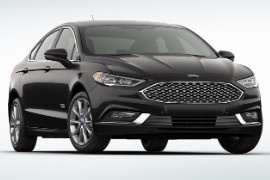
Ford unveiled the facelift for the second generation of the Fusion at the 2016 North American International Motor Show as a 2017 model.
After Ford decided to build the European Mondeo as a Global car, it tried the same with the first generation of the Mondeo, which was translated in the U.S. as the Ford Contour/Mercury Mystique, and the results were under expectations. But the Fusion was a different breed. It was a midsize sedan that offered enough room and comfort for four adult passengers.
The sleek design was built in the European Design Centers and adapted for the American market. Its angry-looking headlights and the 3D pattern on the grille made the car look more stylish than its class. The Fusion Energi featured a similar exterior with the rest of the Fusion range, with only a few details that were different.
Inside, the Fusion Energi was well-garnished with the SYNC 3 infotainment unit. It was able to connect to Apple CarPlay and Android Auto smartphones. For the 2017 model year, the Fusion Energi featured a rotary knob for the gear selector, which was installed on the center console. One of the downsizes of the Energi version was the limited trunk space due to the battery.
The 2017 Ford Fusion Energi was powered by a 2.0-liter four-cylinder engine paired with an electric motor that’s fed by a lithium-ion battery pack. The combined output of 195 horsepower was sent to the front wheels. The plug-in hybrid vehicle could have been completely recharged in 2.5-hours.

The Ford Fusion Hybrid was released in 2012 is a mid-sized sedan.
The most notable aspect on the model is the improved fuel economy since it blends both gas and electric power. The car runs on a 4-cylinder engine and two electric motors (and the battery to charge the electric motors), these making a combined 188 hp.
The Fusion offers a smooth, quiet operation. The styling hasn’t suffered changes, still having the same sleek body. The Fusion Hybrid offers real-time coaching for the driver, to obtain a better fuel economy – the system is named EcoGuide. The car is also equipped with regenerative braking, which captures up to 90% percent of the energy lost through heat while braking and recharges the battery while driving.
In its standard trim level, the car has active noise cancellation. The interior’s design is attractive, having a touchscreen infotainment system. Bluetooth is available as well. The standard trim level also includes features such as: automatic transmission, automatic air-conditioning, back-up camera, ABS, ESC and of course, the mandatory front airbags for every new car.
As optional features, Ford offered a powered moon-roof, adaptive cruise control, leather upholstery, navigation system, lane departure warning, blind spot warning system, rear view camera, automatic park assist. Fully charged, the car should have a combined total range of 550 miles.

With lots of strong competitors on the market such as the restyled Honda Accord and the Mazda 6, the refreshed Ford Fusion managed to stand out with its appealing design.
Various updates were made over the years to keep the Fusion fresh, and for 2019, Ford updated the exterior design and added even more standard features.
For 2019, the 5-passenger midsize sedan was available in 5 trim levels: the S, the SE, the SEL, the Titanium and the V6 Sport.
We found the base trim level to be well-equipped, with the Fusion featuring a 2.5-liter 4-cylinder engine that developed 173 hp. A front-wheel-drive system was standard and the powerplant was mated with a 6-speed automatic transmission.
The standard features included 16-inch steel wheels, automatic headlights, cruise control, air-conditioning, a rearview camera, Bluetooth connectivity, a 4.2-inch display and an USB port. The Co-Pilot360 Protect package added blind-spot monitoring with rear cross-traffic alert, forward collision mitigation and lane keeping assist.
The 2.5-liter unit was a little underpowered and for the ones looking for a punchy engine, the upper trim levels or even the top-of-the-range would had been a better choice.
Moving to the upper SEL trim level, the Fusion featured LED headlights, adaptive cruise control and a navigation system. Starting with this trim level, the all-wheel-drive system became available. Also standard were an automatic stop-start system, 17-inch alloys, rear heat ducts, an 8-inch touchscreen, Apply CarPlay and Android Auto, a navigation system, as well as two USB ports.
The SE appearance package was optional and added 18-inch black wheels and a leather-wrapped steering wheel.
The SEL trim level was comfort and practicality oriented, while the Titanium was equipped with the more powerful 2.0-liter turbocharged engine, 19-inch alloys and more luxurious features.
As expected, the V6 Sport offered the most powerful engine in the range, a 2.7-liter turbocharged V6 engine that developed 325 hp. Besides the slightly different exterior look, the top-of-the-range offered an adjustable suspension and even an automated parking system for parallel and perpendicular parking.
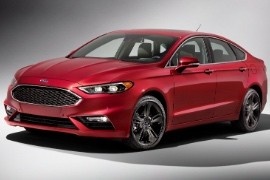
Ford introduced a mid-life cycle refresh for the Fusion in 2016 and brought more than just some new rims, bumpers, and headlights.
While it shared the platform and the shape with the European Ford Mondeo, the Fusion offered more than any of its European siblings could hope for. For the 2017 model year, the carmaker produced the sporty sedan in a complete package that could satisfy the environmentalists or the petrolheads as well.
There were some minor changes on the regular versions from the outside, which included a new bumper and fog lights. The car featured a honeycomb grille at the front with an A-shaped lower apron for the sport version. In the back, for the sport version, Ford installed four exhaust pipes. Ford made a bold move for its family sedan range.
Inside, the carmaker introduced the SYNC3 infotainment system that tried to compete with the rest of the Android-compatible units offered by other carmakers. But the most significant novelty was the rotary gear selector placed on the center console for the entire range. For the hybrid version, the 2017 Fusion offered less trunk space than its siblings, but it showed a significant increase in the car’s fuel efficiency, and thanks to the plug-in system, it provided more than 20 miles (32 km) of pure electric range.
The most significant novelty for the drivetrain was the twin-turbocharged V-6 engine. It provided 325 hp and sent the power in all corners. That version placed the Fusion Sport into a completely new category of sport sedans, competing directly with Subarus and other all-wheel-drive vehicles.
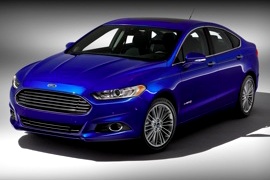
Ford’s player in the most competitive segment in the industry, the Ford Fusion was a mid-size sedan redesigned for 2012.
The new model was completely refreshed having a beautiful and modern design, somewhat reminiscent of an Aston Martin with its front grille, the angular headlights and the sopping hood.
A new, more efficient engine replaced the old 2.5-liter unit. The 2.0-liter Atkinson-cycle 4-cylinder engine developed 141 hp, and paired with an electric propulsion system, the new Fusion had 188 hp under the hood.
The single transmission option was a CVT, which paired with the 2.0-liter unit offered a reduced fuel consumption.
As expected, the batteries took a little of the storage available in the trunk, however, the cargo capacity remained a decent one, with a lot of usable space.
Inside, the Fusion offered decent seating for 5 full size adults. The new seats made of recyclable materials were incredibly supportive and comfortable. However, the aggressive slopping roof design reduced the headroom available in the back.
The dash was more modern than ever with Scandinavian influences, similar to Volvo’s with the open area in the center console. The quality of materials was highly improved and the capacitive touch buttons were a nice feature.
Another nice thing was the great turning radius which came in handy around town.
With this model, it seemed that Ford came a long way. The new Fusion offered high fuel economy, featured advanced technology and lots of safety features, all wrapped up in an eye-catching vehicle.

The 2013 Ford Fusion Energi moved from hybrid to the plug-in hybrid and, with a specially designed and engineered engine to help, it grew the EV range.
Ford Fusion was the American name for the European Ford Mondeo. There were some differences between the two brothers from both sides of the Atlantic, but technically speaking, they were very similar.
From the outside, it was difficult to tell the difference between the Fusion Energi and the Fusion Hybrid. The only noticeable difference was on the left front fender where the Energi featured a round cap for the charging plug. With a shape that was no longer the conservative three-box design, it offered a sleeker, more aerodynamic look.
Inside, there was a roomy interior with room for five adults. The bolstered front seats were fitted as standard in the Energi. The instrument cluster featured an analog dial in the middle for the speedometer and two TFT screens on its sides. On the center console, there was the MyFord Touch infotainment unit. It allowed the driver to interact with vehicle systems through voice control, a touch screen tap or a conventional button. The battery pack was placed in the trunk, killing a big chunk of its room.
The Ford Fusion Energi plug-in hybrid used the same 2.0-liter four-cylinder found in the Fusion Hybrid along with an electric motor and lithium-ion battery pack. Fusion Energi was designed to run on pure electric power for short commutes and could have been charged using a 120-volt or 240-volt outlet.
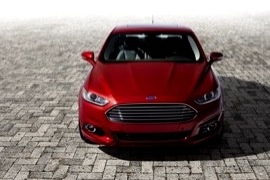
When the first generation of the Mondeo was translated on the U.S. soil, it didn’t win too many buyers. But the blue-oval company tried again in 2012 with the introduction of the Fusion.
A car company will always want to sell as many vehicles as it can from the same model so that the development costs would pay off faster. While the costs for development of the first generation of the Mondeo were 1 billion U.S. dollars, the car was a flop on the American market with less than 300.000 units sold from Ford Contour and Mercury Mystique (the names for the U.S. version of the Mondeo). In Europe, it was an instant hit and it became the 1994 class leader.
In 2012, the Fusion took the same design from the European Mondeo. This time, there was cooperation between the American and the European design teams, and that led to a different approach to the market. Its sales went through the roof with over 300.000 units at its peak. The hexagonal wide grille, the dynamic look, and the swept-back bodywork conquered the buyers.
Inside, Ford brought the latest iteration of the award-winning, SYNC communications and entertainment system, which enabled voice-activated communication through a driver’s mobile phone and interaction with the car’s audio system. The comfortable seats and the roomy interior were other important key-factors.
For the engine department, Ford introduced fuel-efficient engines, a hybrid, and a plug-in hybrid version that proved to give hard times for Toyota’s hybrid vehicles.
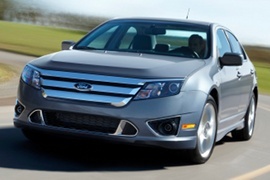
Ford mixed a bold exterior styling with a sporty platform carried over from Mazda6, and the result was the 2006 Fusion, and then added a few updates for the 2008 model.
Despite the world financial crisis, Ford decided on pushing forward the mid-sized sedan, trying to edge its competitors who struggled to save their resources to face the tough times, and its strategy worked well. It didn’t want to be an American version of a Camry or an Accord but managed to give its customers a mid-size sedan that looked more upmarket and innovative.
The 2008 model featured a refreshed front end with thicker horizontal chromed slats over the grille. Its headlights swept-back on their upper side resembled its European brother that shared its Fusion name, even though that was a small hatchback. Its front bumper was different, depending on the trim level, and sported either a wide opening at the bottom with a chromed surrounding or a two-chromed slat grille.
Inside, Ford installed a choice of instrument clusters depending on the trim level. That was unusual for any carmaker in those times. It was available either with a four-dials layout inspired by the European Mondeo, three-dials arrangement, or a very modern design that sported the speedometer in the middle flanked on both sides by LCDs.
Since it shared its underpinnings with Mazda 6, the Fusion received a V-6 and an all-wheel-drive system, which came to complete the powertrain offer. The base version retained the inline-four unit from the 2006 model. It also came with a fuel-efficient hybrid version, which proved that it could run at a lower cost per mile than its core competitors, the Camry and the Accord.

Ford Fusion stood between the Taurus and the Focus gap, and it was based on the same platform as the Mazda 6 and Lincoln Zephyr.
The 2006 Fusion was a significant departure from the regular Ford sedans. It not only looked different, but it was built to compete against sporty sedans such as Honda Accord, Toyota Camry, or Hyundai Sonata.
From the front, the Fusion featured Ford’s new design language with three slats on the grille. Its squared, and swept-back over the hood headlights were different than any other Ford sedan on the U.S. market. Its sporty profile with a raked windshield and sloped rear window showed a different perspective about the American carmaker. In the rear, Ford installed triangular taillights, similar to those installed on the European Mondeo or on the four-door Focus.
Even if it shared the same platform as the Mazda 6, it sported a longer wheelbase to offer more interior room, especially for those in the back. Its front bucket-seats were wide but just slightly bolstered and didn’t show any tendencies to hold their occupants in place during hard cornering. Its dashboard resembled the European Mondeo, which was not imported or produced for the U.S. market. Inside the instrument cluster, the carmaker installed large dials for the speedometer and tachometer and smaller gauges for the fuel level and temperature gauges. The designers encircled all of them with silver rims to create an upmarket image.
The Fusion featured two engine choices. While the base version was powered by a 2.3-liter shared with Mazda, the full options received a 3.0-liter V-6. Both of them were paired to a 6-speed automatic transmission.























































